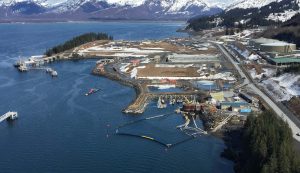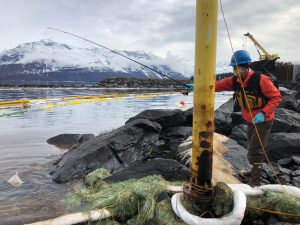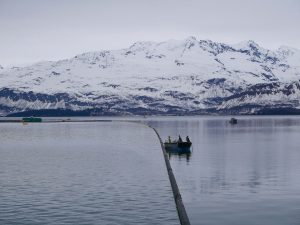
On April 12, a sheen was reported near the small boat harbor at the Valdez Marine Terminal. Investigations identified the source as a sump which overflowed. The primary causes of the spill have been identified as the failure of a check valve and a level indicator.
The check valve became clogged with debris.
A level indicator was not functioning. This failure also kept the high-level alarm from activating.
While the level indicator should have prevented the incident, human error also played a factor. A technician conducting rounds did not verify the sump level due to a headlamp failure. This action had the potential to prevent or reduce the volume of the spill.
What happened?
When the systems are working properly, rainwater from the nearby area drains into the sump, which is then pumped into the terminal’s industrial wastewater system. That wastewater system empties into the ballast water treatment system.
The investigation showed that the check valve became clogged with debris at an unknown point and was unable to fully close. This allowed oily water from the ballast water facility’s pipes to flow into the sump.
The level indicator in the sump was supposed to sense rising liquids and automatically turn on the sump’s pump when the liquid level reached a certain height, to pump out the excess liquids. Because that level indicator failed, the rising oil and water mix overflowed the sump.
Discovery, containment, and cleanup
The sump was identified as the source of the spill within a few days, however the pathway the oily water took from the sump to the water took time and extensive excavation to discover.

When the systems failed, the oily water seeped through the soils around the sump and entered an old drainpipe, which directed the spill into Port Valdez. The pipe had been installed before the terminal was built to prepare the site for its construction. It was later buried and forgotten until Alyeska discovered it while investigating the spill’s path.
Oil continued to seep into Port Valdez until the end of April as oil already in the ground worked its way to water. In early May, a temporary pipeline was completed, which captures the seeping oil and redirects it to the ballast water treatment facility. No more oil is reaching water, however cleanup on land is expected to continue through the fall.
The spill and subsequent cleanup activities did not impact the tanker loading berths and oil shipping continued throughout the incident response.
All responders have been required to adhere to safety guidelines to mitigate the spread of COVID-19. Council staff and volunteers continue to monitor the situation from a safe distance.
Communications with Council

“While preventing oil from reaching the water is always the ultimate goal, Alyeska was proactive and responded to this incident with trained personnel and pre-contracted fishing vessels who were successful in mitigating impacts to the environment,” said Donna Schantz, executive director for the Council.
“Additionally, the Unified Command, including Alyeska as the responsible party, provided us with information and included us in meetings and updates,” she added.
“This was a great example of how we were designed to work together.”
Investigation complete
Alyeska’s investigation into the cause of the spill was completed in early July. The Council has received information regarding the investigation from Alyeska, including information about the causes and other contributing factors, and will be following up on next steps. Many sumps like this are located throughout the terminal and the Council is interested in Alyeska’s measures to prevent this type of occurrence in the future.
Links: